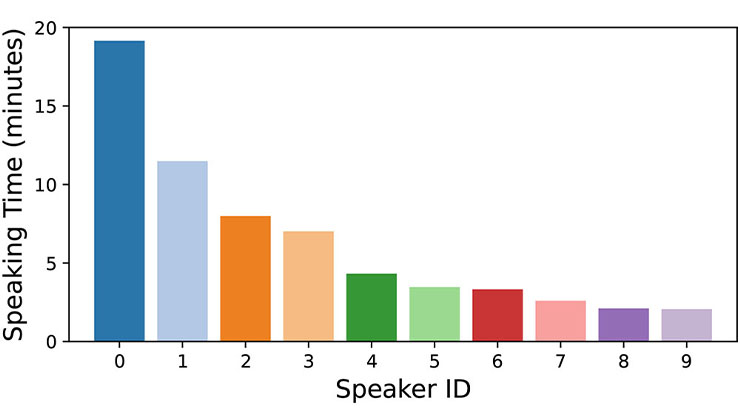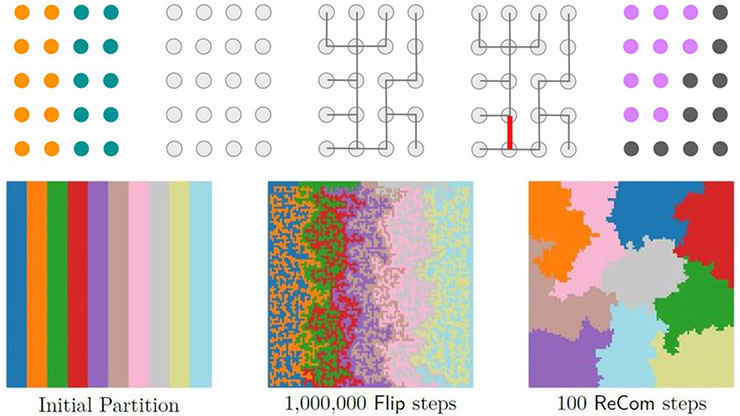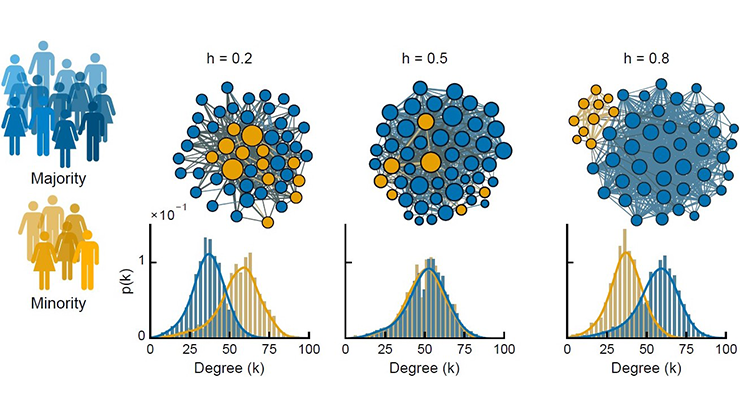Opinion Dynamics in Social Networks: Kinetic and Data-driven Modeling
In recent years, kinetic models have become a powerful approach for the analysis of interacting agents’ collective behavior across various domains. In economics, these methods further our understanding of market dynamics, help predict bubbles and crashes, and describe wealth distribution and inequality [11]. In biology, kinetic theory can model disease spread and evaluate the effectiveness of measures like vaccination and quarantine, even in spatially heterogeneous populations [4]. Further applications in the social sciences include the study of information diffusion and crowd behaviors, while engineering disciplines benefit from an advanced understanding of traffic flow and communication networks [1].
Among these numerous functionalities, the dynamics of opinion formation—i.e., the evolution and spread of opinions within a population—holds particular social relevance and encompasses phenomena such as political polarization and consensus. Statistical physics (and particularly kinetic modeling) provides effective tools to analyze these processes, with the concept of emergent behavior playing a central role. Emergence—when collective properties arise from individual interactions—manifests in opinion formation with clusters, polarization, consensus, or influential opinion leaders [3, 12]. Here, we present a kinetic opinion model wherein individuals have varying abilities to attract consensus based on their connections [2]. We extract data from a social network and use it to estimate opinion and connection distributions.
Mathematical Model for Opinions and Contacts
To begin, we consider a system of indistinguishable agents that interact over a social network. These agents are characterized at each time \(t\geq 0\) by their number of social media followers—which we refer to as \(c>0\)—and their opinions on a given topic, which we model with a continuous variable \(v\in I=[-1,1]\).
![<strong>Figure 1.</strong> Shape of the value function \(\Psi^\varepsilon_\delta\) for different \(\delta\). Figure adapted from [2].](/media/qiman5n4/figure1.jpg)
As with previous social climbing problems [6], we can reasonably assume that the formation of a network begins with the collective will of all participants to interact and be heard by one another. Consequently, each agent is likely motivated to increase their number of connections upon entering a new platform by engaging with other agents. We assume that for most participants, there exists a certain number of social contacts—denoted by \(\bar c\)—at which they feel satisfied. This assumption implies that the microscopic interactions within the network reflect the agents’ tendency to achieve, at a minimum, a number of followers that is equal to \(\bar c\).
To describe the evolution of the degree distribution of connections in such a network, we draw inspiration from the prospect theory of Daniel Kahneman and Amos Tversky [10]. Specifically, we model the microscopic variation in the number of contacts for each agent in the network as
\[c' = c - \Psi^\varepsilon_\delta(c/\bar c) c +\sqrt{\varepsilon}c\eta, \tag1\]
where \(\varepsilon>0\) is a positive parameter and \(\eta\) is a bounded random variable with average \(\langle\eta\rangle=0\) and variance \(\langle \eta^2 \rangle=\nu^2\). The value function \(\Psi^\varepsilon_\delta(s)\), \(s\geq 0\), is a dimensionless increasing function that is equal to zero at \(s=1\). This function is asymmetric; if two agents start at the same distance \(\Delta s\) from reference point \(s=1\), moving closer to \(s=1\) will be easier for the agent who is initially below the reference point (rather than above). Figure 1 illustrates a possible representation of the value function.
To describe the evolution of opinions, we begin with the microscopic interactions between individuals on a social platform [12]. The main novelty of our work is that we account for the possibility that the opinions of people with a large number of connections have a stronger impact on the community and consequently affect other people’s opinions more easily. At the microscopic scale, we assume that binary interactions between individuals obey the following dynamics:
\[\begin{eqnarray} v' & =& v + \varepsilon P(v,v_*,c,c_*)(v_*-v) +\sqrt{\varepsilon}D(v,c)\xi,\\ v'_* & = & v_* + \varepsilon P(v_*,v,c_*,c)(v-v_*)+\sqrt{\varepsilon}D(v_*,c_*)\xi_*. \end{eqnarray} \tag2\]
Here, \(v\) and \(v_*\) are the agents’ opinions before the interaction, while \(v'\) and \(v'_*\) are their opinions afterwards. The function \(P\) in \((2)\) is the compromise propensity of the agent, which we suppose to be dependent on popularity. The function \(D\), in turn, weights the influence of effects that are introduced by the background. We multiply \(D\) by the random variable \(\xi\), where \(\langle \xi \rangle =0\) and \(\langle \xi^2 \rangle =\sigma^2\). In the general case of \((2)\), the post-interaction opinions depend on both participants’ number of connections.
To visualize the evolution of the microscopic dynamics in \((1)\) and \((2)\) at a statistical level, we consider the joint probability density of opinions and contacts: namely \(f(v,c,t)\). It is hence possible to characterize the evolution of such distribution agents and understand their global behavior via statistical mechanics [2, 11, 12]. By utilizing a quasi-invariant opinion limit—i.e., considering the time scaling \(t=t / \varepsilon\) and taking the limit for \(\varepsilon\) to zero—we can characterize the asymptotic behavior of this statistical process according to the solution of the following Fokker-Planck model:
\[\partial_t f=-\partial_v \left(\mathcal{P}[f](v,c,t) f \right) + \partial_c\left( \Psi_\delta(c)cf\right)+ \frac 12 \sigma^2 \partial^2_v (D^2(v,c)f) + \frac 12 \nu ^2 \partial^2_c( c^2f), \tag3\]
where \(\mathcal{P}[f](v,c,t)\) is a nonlocal operator that models the compromise propensity and \(\Psi_\delta(c)\) is the limit of the scaled value function in \((1)\) as \(\varepsilon \to 0\).
Animations 1 and 2 depict the evolution of agents when governed by a compromise function \(P(\cdot)\), where the influence of agents with a larger number of contacts has a larger weight. Animation 1 shows that agents who become increasingly popular as time passes tend to polarize their opinions around \(-0.5\) and \(0.5\), while those who maintain a lower number of social media contacts tend to reach consensus around the central opinion. In Animation 2, the distribution of the connection is fixed and only opinions evolve over time.
Model Calibration From Social Media Data
The dynamics of network connections and social media opinions typically occur at different time scales, which makes it possible to separate the variables and study the steady state distribution of the contacts. To match the model setting with a realistic scenario, we retrieved 2022 data from Twitter (now X) on the statistical distribution of the number of connections, then performed a best-fit analysis with the analytical steady state of contacts from the Fokker-Planck model \((3)\). Figure 2 shows multiple steady state solutions that correspond to different choices of the value function \(\Psi_\delta\). Lognormal density obtains the best fit in this case.
![<strong>Figure 2.</strong> Comparison between the tails of the data distribution from X (formerly Twitter) and the equilibrium distributions from the Fokker-Planck model with different options for limiting value function \(\Psi_\delta\): lognormal \((\delta = 0)\), Amoroso \((0<\delta <1)\), and inverse Gamma \((\delta = 1)\). Figure courtesy of [2].](/media/opniupnu/figure2.jpg)
After finding the distribution of contacts that best fits real networks, we applied sentiment analysis tools to address the key challenge of quantifying opinions from real data. Using Twitter’s former application programming interface, we collected tweets that mentioned “Donald Trump” shortly after his readmittance to Twitter in November 2022, following a two-year ban. To score the sentiments of each tweet, we employed a text analysis tool called Valence Aware Dictionary and sEntiment Reasoner (VADER) that combines qualitative and quantitative methods, leveraging a valence-based lexicon that is curated from crowd-sourced ratings [9]. VADER is optimized for social media text and accounts for emoticons, acronyms, slang, and other features without requiring a training dataset. The tool assigns sentiment scores that are normalized to \([-1, +1]\) and applies heuristics based on grammatical and syntactic cues to determine sentiment intensity.
We successively calibrated the model under the assumption that the connection distribution remains in a stationary lognormal state. The opinion distribution that we inferred from the data is given by \(\hat{g}(v,t)\), while \(g(v,t)\) represents the opinion marginal of \(f(v,c,t)\) that we obtained by simulating the virtual dynamics of a large ensemble of agents. In Figure 3, we compare our results with the data. Figure 3a depicts the marginal opinion distribution at time \(t=20\) alongside the corresponding data, while Figure 3b displays \(f(v,c,t)\)—the reconstructed density of agents with opinion \(v\) and number of contacts \(c\) at time \(t\)—rendered as \(\log(f(v,c,t) + 0.025)\) and superimposed to Twitter data (represented by the orange dots).
![<strong>Figure 3.</strong> Comparison between the reconstructed density of opinions and the real data set. <strong>3a.</strong> Marginal distribution of opinions at the final time. <strong>3b.</strong> Joint distribution of opinions and contacts. Figure courtesy of [2].](/media/ppiltgvt/figure3.jpg)
Conclusions and Perspectives
Our kinetic model provides a flexible framework that allows us to examine the relationship between opinion dynamics and social media networks, capturing key heterogeneous patterns such as polarization and consensus over social network connections. The comparison with real-world data outlines the model’s relevance in furthering our knowledge of social media’s effect on public opinion.
Further developments have extended our understanding of opinion dynamics in significant ways. For example, a 2024 study employed a control mechanism to steer agents away from the mean opinion, thus preventing clustering and maintaining opinion diversity [7]. Another recent investigation explored the role of diffusion in condensation phenomena, establishing a relationship between Bose-Einstein condensates, finite time blow-up, and consensus [5]. Lastly, some novel models employ ordinary and stochastic differential equations to examine polarization phenomena [8]; these models incorporate persuaders, time scale effects, and uncertainty to identify stationary polarized distributions and analyze their stability under varying parameter conditions.
These advancements enrich our understanding of the way in which individual interactions and external influences shape collective opinion dynamics, ultimately offering valuable frameworks for issues like polarization and the preservation of opinion diversity.
Giacomo Albi delivered a minisymposium presentation on this research at the 2024 SIAM Conference on the Life Sciences, which took place in Portland, Ore., last year.
References
[1] Albi, G., Bellomo, N., Fermo, L., Ha, S.-Y., Kim, J., Pareschi, L., … Soler, J. (2019). Vehicular traffic, crowds, and swarms: From kinetic theory and multiscale methods to applications and research perspectives. Math. Models Methods Appl. Sci., 29(10), 1901-2005.
[2] Albi, G., Calzola, E., & Dimarco, G. (2025). A data-driven kinetic model for opinion dynamics with social network contacts. Eur. J. Appl. Math., 36(2), 264-290.
[3] Albi, G., Pareschi, L., & Zanella, M. (2017). Opinion dynamics over complex networks: Kinetic modelling and numerical methods. Kinet. Relat. Mod., 10(1), 1-32.
[4] Boscheri, W., Dimarco, G., & Pareschi, L. (2021). Modeling and simulating the spatial spread of an epidemic through multiscale kinetic transport equations. Math. Models Methods Appl. Sci., 31(6), 1059-1097.
[5] Calzola, E., Dimarco, G., Toscani, G., & Zanella, M. (2024). Emergence of condensation patterns in kinetic equations for opinion dynamics. Phys. D: Nonlinear Phenom., 470(A), 134356.
[6] Dimarco, G., & Toscani, G. (2020). Social climbing and Amoroso distribution. Math. Models Methods Appl. Sci., 30(11), 2229-2262.
[7] Düring, B., Franceschi, J., Wolfram, M.-T., & Zanella, M. (2024). Breaking consensus in kinetic opinion formation models on graphons. J. Nonlinear Sci., 34, 79.
[8] Franceschi, J., Pareschi, L., Bellodi, E., Gavanelli, M., & Bresadola, M. (2023). Modeling opinion polarization on social media: Application to COVID-19 vaccination hesitancy in Italy. PLoS One, 18(10), e0291993.
[9] Hutto, C., & Gilbert, E. (2014). VADER: A parsimonious rule-based model for sentiment analysis of social media text. In Proc. Internat. AAAI Conf. Web Social Media, 8(1), 216-225.
[10] Kahneman, D., & Tversky, A. (2013). Prospect theory: An analysis of decision under risk. In L.C. MacLean & W.T. Ziemba (Eds.), Handbook of the fundamentals of financial decision making: Part I (pp. 99-127). World Scientific handbook in financial economic series (Vol. 4). Hackensack, NJ: World Scientific.
[11] Pareschi, L., & Toscani, G. (2014). Wealth distribution and collective knowledge: A Boltzmann approach. Phil. Trans. R. Soc. A: Math. Phys. Eng. Sci., 372(2028), 20130396.
[12] Toscani, G. (2006). Kinetic models of opinion formation. Commun. Math. Sci., 4(3), 481-496.
About the Authors
Giacomo Albi
Associate professor, University of Verona
Giacomo Albi is an associate professor of numerical analysis at the University of Verona in Italy. His research focuses on numerical methods for partial differential equations, optimal control of high-dimensional systems, and kinetic modeling of multi-agent systems.

Elisa Calzola
Research fellow, University of Verona
Elisa Calzola is a research fellow in numerical analysis at the University of Verona in Italy. She earned her Ph.D. in mathematics at Sapienza University of Rome, with a focus on semi-Lagrangian schemes for partial differential equations. Calzola’s research interests include numerical methods for optimal control and data-driven modeling of opinion dynamics and epidemics.

Giacomo Dimarco
Full professor, University of Ferrara
Giacomo Dimarco is a full professor of applied mathematics at the University of Ferrara, where he is also head of the Department of Mathematics and Computer Science and director of the Center for Modeling, Computing and Statistics. His research focuses on numerical methods for kinetic equations, multiscale modeling, and uncertainty quantification.

Related Reading
Stay Up-to-Date with Email Alerts
Sign up for our monthly newsletter and emails about other topics of your choosing.






